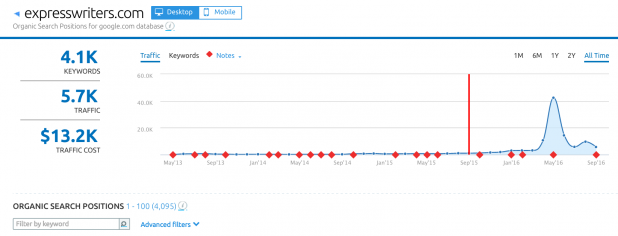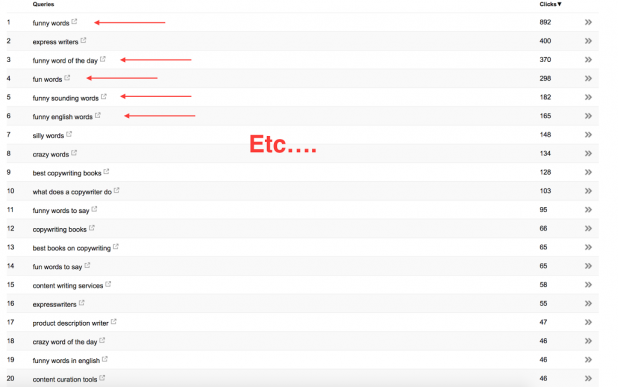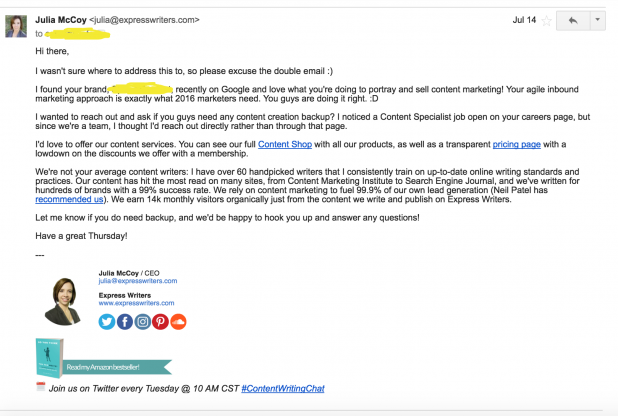
Check out this screenshot of an overview of our rankings for a year span (May 2015—September 2016).
Scary, right?
What happened in May looks great—but why couldn’t we hold onto it?
Isn’t any traffic drop a bad thing?
Actually, no.
I’m going to reveal just why an immense amount of traffic is worth absolute crap if you aren’t earning ROI from it—and why the dip you see below was the best thing that could have happened to my company this year.
I removed, on purpose, the organically high-ranking post responsible for my huge traffic bump—and I went after the traffic I wanted. I didn’t spend a dime on ads and was able to increase my revenue by 25 percent — that’s right, the same figure in the traffic I lost—with my new lead approach.
First…
A Little Backstory
My site, expresswriters.com, has managed to dominate in Google SERPs—simply because I’ve stayed on top of producing a consistent amount of well-optimized, well-written content. (Here’s a case study I did with more on that.)
By now, we have more than 770 published blogs, and 95 site pages. We’re close to nearing the 1,000-page mark. We started publishing the first blog back on our WordPress in September 2012: and today, our organic rankings through our own written content put us at 4,200 indexed keywords, with more than 300 keywords in the top 10 positions on Google. From just a year ago, we’ve doubled our rankings and organic presence with a consistent content presence. (It would have been tripled, but we chose to lose some traffic on purpose. More below.)
Overall, we have 4,100 keywords total indexed, for a traffic value of 5,700/monthly that equates to $13,200, if we were to pay for the same traffic in PPC.
Now, let’s get to the meat of today’s post where I share with you the reasons behind that scary dip you see from the SEMrush screenshot in our traffic—and why we intentionally chose to remove a non-ROI focused post that originally got us our huge jump in rankings and traffic. Plus, I’m also going to detail how I went after the traffic I wanted instead, and succeeded: without a single penny spent in ad money.
Ready?
How it All Started: The Audit of All Audits
In June, I started an in-depth study of our rankings, and I began auditing our site like I’d never done before.
This was sparked by several things. I had a growing mindset that started with my Twitter chat that launched in January of 2016, and my book and podcast that was launched in spring 2016.
The amount of ridiculously hard work that went into all three of those things made me become a very meticulous content creator.
You might say anal.
When you spend a year writing a book (and I self-published it—which means rounds and rounds of burning my eyes out to catch every single typo)—or five hours struggling over editing and perfecting just 10 minutes of a recorded podcast you’re publishing, you’ll understand.
When I put my nose into a deep audit (primarily using SEMrush and as a backup, Google Analytics), one disturbing finding I discovered was that more than 30 percent of our traffic was entirely built around the keyword funny words—and six related keywords to that one.
Funny sounding words, crazy words, etc.
Not so funny, when we sat down and questioned if this traffic stream led to ROI for us. Look at the bounce rate:
I myself talked to a lead on chat that clicked through and read the blog. He LOL’ed, said the blog was great, and told me that he was saving it for later to share with his wife. Then he left.
It hit me—does our largest stream of traffic even convert?
Devastating. I didn’t want to dig in, but I did. I looked at the history of chat from that page. It was ugly. People said hi. Some even sent a picture of themselves. (WTH?) In other words, they were time-wasters. Because while that feedback was friendly and all, it wasn’t translating to ROI. And why were we paying for the chat software, paying for our chat representative’s time when this post didn’t convert a single visitor?
Let’s not sugarcoat. Compliments are great, but sales are better. ROI. In the end, from what you do as a marketer, that’s what you want—and need, to live.
Was it worth our time?
I took the question of “what do I do with this unrelated, non-ROI focused traffic” here on Inbound.org, and received varying advice.
After a lot of internal debate, we simply decided to redirect the “funny words” blog to our main blog landing page.
I didn’t do it without making a firm promise to myself, being the entrepreneur I am—I will find and replace this traffic with worthwhile, revenue-making traffic! (I had no idea just how much ROI-focused traffic I’d be bringing on inside just a few months.)
The rankings slowly but surely dropped away. Traffic dipped, big-time. As the rankings dropped, we noticed something: our chat messages went up in ROI—although we had less coming in. With that extra time, we focused on No. 1 in the processes below. And when we started doing No. 2 (also explained below), our chat messages increased—they were even more than when we had all the traffic from the funny words blog coming to our site!
How I Went After the Leads I Wanted, and Brought in A Stream of 30 Percent New Revenue
I did that in two key ways. Here’s how.
1. I Decided to Hunt Down the Traffic I Wanted
Mid-July, my site audit results and brainstorming took me to a new idea.
Why not go after the type of leads I want?
Early 2016, I’d been frustrated by many organic Google leads. Many of our keywords ranking in No. 1 were similar to “seo content writers for hire.” The leads coming in were cheap, cheaply minded and difficult to work with. They didn’t prize or value the hard work that went into writing their content.
After some intense researching, I discovered that a “content marketing agency” fit the bill for our near-perfect ideal client type. This lead understood the value of content, and didn’t need to be taught; and the nature of their revenue-driven client relationships meant that they needed a lot of well-written content, consistently.
So, I looked up some content marketing agencies in two places: a national Google search, and a search in my own hometown of Austin, Texas. I drafted the following e-mail and sent it out, in variations, to five companies.
I drew up a very simple e-mail that met three elements that I felt were essential to content marketers (and I’m a content marketer, so I was pretty sure this could work):
- Included a 100 percent authentic compliment: why I liked their company, pointing to a clear reason on why I think we’d work awesomely together.
- Friendly, not sales-driven, and natural. No sales drivel. I hated that voice—I’m sure they did too.
- Powerful: a real reason to trust my team and me. (Neil Patel recommended us, so that helped.)
Within hours, two out of the five replied. I’d sent the e-mails randomly—2PM, and 4PM. Both leads that replied set up a call that happened that week. We had amazing conversations. I found like-minded people that, just like me, knew and prized the value of great content marketing. There was no funnel process needed. They converted in a few days after the first phone call.
The gross worth of two of these leads so far—and this is early in our relationship—has just surpassed $6,000 gross. I’m even talking this week with one of the two leads about doing in-house mentoring for the entire office of one of the leads, worth about $2,500.
We’ve repeated this process—it’s had varying levels of success, with different staff members. Another expert copy client that one of the staff was able to interest in our services, using my exact template (literally a copy/paste), has converted at $11,000 total so far. And they have monthly needs, so this will be ongoing amounts.
That’s $17,000 in revenue I would never have seen if I didn’t go after the traffic I wanted. And that’s a solid quarter of a month’s worth of income for my business—in this one approach alone, I added 25 percent new revenue to my business, from brand new leads.
So, process No. 1 has worked tremendously well: we’ll keep fine tuning it and use it as a major form of bringing in the clients we want the rest of this year.
2. I Updated Old, Icky Blogs: A Google Trial With 24 Updated Pieces of 1,000+ Words of New Content
Along with the “funny words” finding in June, I started digging in and re-reading all of my earliest posts published on my site.
I was horrified. I found ugly, early-newbie blogger syndrome in every post I read. The content, honestly, was “ugly” compared to the topics and content that I was creating for my blog now.
I immediately deleted 19 pieces of content that were entirely non-relevant to our services, of no use to our ideal audience type, and some that were just low quality. (I handed the links to my CTO, Josh, who properly re-routed them).
Hand-in-hand with removing these non-conversion oriented posts, I began an in-depth rewrite process of all the old posts that held major rankings—those that ranked anywhere from No. 1 to No. 3 for highly relevant keywords, like “what is copywriting” or “direct e-mail copywriting.” They required a lot of work—to a point where I just threw up my hands and decided to rewrite most of the content.
It ranked highly, but read poorly: what’s the good in that? So I did a major, major post refresh.
Example: this post ranked No. 2 for “writing for dummies.” Here’s a summary on the number of ways for how I refreshed it:
- Rewrote it with content that read better (the old content was stale and not so well-written). The final new content was 95 percent unique from the previous content—close to being an entirely new post.
- Had our designer create and add a brand new image.
- Wrote a new CTA.
- Another change was that the voice was completely different—in the old one, I spoke to the audience as if they were “dummies” and assumed they didn’t know much. Not so much in the new one. I treated it like a useful guide for an already-intelligent reader.
- To wrap it up, I wrote a fresh meta, updated the URL slug, and wrote a new meta title.
This was one out of 24 individual pieces so far that I’ve completed updating the same intensive way, with the help of my team, since starting the audit last June – 24 rounds of fresh rewrites, updated ideas and links at 1,000 words minimum per post. Fresh content, images, metas, titles, slugs, tags, etc.
On many of the posts, we added 500+ more words of in-depth content, like this one on what is copywriting. For some, we updated the publish date forward a few years since we added more, relevant, current information.
What happened in the rankings?
Google appreciated what we did (long sigh of relief).
I saw rankings go down overnight for the rewritten posts—then rise right back up in a few days, to the tune of gaining more than 25 positions each day. (I’m using SEMrush for the following screenshots. Highly recommend.)
Examples: this post on email copywriting (see the arrow and growth in 26 new spots of rankings—that happened overnight):
Check out another completely updated blog that was ranking for the keyword “press release outline.” We lost all our rankings when I refreshed it, and then a week later gained 96 spots back.
Here’s another post about Web content writing and editing that went down considerably for that keyword, then back up 30 spots to No. 6 in the SERPs after refreshing:
In a 72-hour to one-week span, we ended up holding the same rankings for many of the high-ranking posts that we rewrote to new standards.
Google appreciated the updates, from all we could tell so far. (We’re still updating more posts as we speak.)
Our chat messages on Drift have increased—and people approach us with a new mindset, all related to the higher caliber of quality now in our organic rankings on Google. It’s been cool to see the change in the messages that come in now.
- Example of a typical chat message when we had our old posts indexed in Google: “I’m not sure I want to go with you guys vs. your competitors. Can you tell me why you’re better?”
- Example of a typical chat message with our new posts indexed in Google: “Your agency looks really good. How can I get started blogging?”
The Greatest Change of All: A Mindset I Completely Left Behind This Year
I’ll be honest.
Unfortunately, back in 2012, my content mindset was nowhere near what it is today.
It was more like write fast, publish faster.
That got me in a pit of publishing some content I’m really not proud of today.
When I audited our rankings and discovered the not-so-fun funny word stuff, I decided it was time to take action and improve my standards on all our content. What else were we ranking for that I didn’t want to be known for? What about the low quality stuff?
Inwardly, this was a hard truth to face.
You might as well call 2016 the year of the Meticulous Julia McCoy. At least that’s how I’ve felt after burning my eyes and fingers out. But it’s all been worth it. I feel much, much more relieved about the content you see in the first 10 results of Google for the various keywords we rank for.
It’s content I want my readers to read.
Not just content that’s a placeholder for leads.
And the new lead process? It’s working, and there’s no telling where we’ll end up with that.
Stuck in a rut? Not happy with your traffic? I’m here sharing this today to show you that you don’t have to settle! Be inspired and dig in. Don’t settle for less. Change up your style, direction, and structure—whatever it takes to get your ideal lead—and watch what happens. The results may amaze you!
By Julia McCoy












